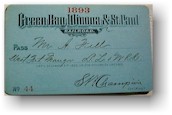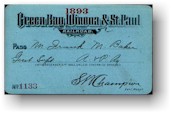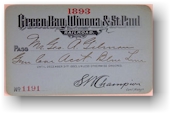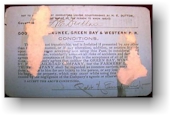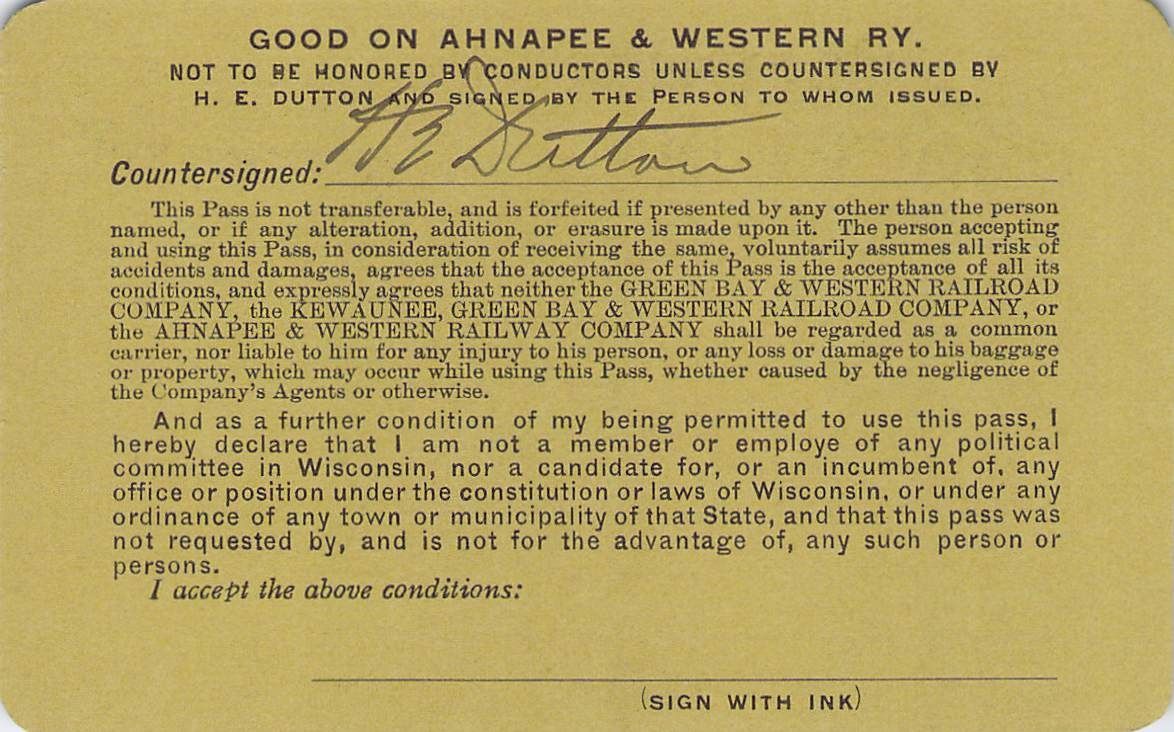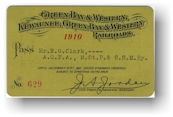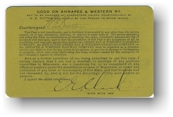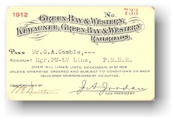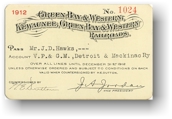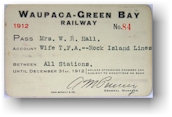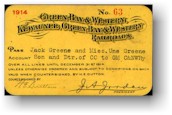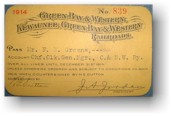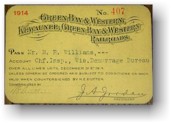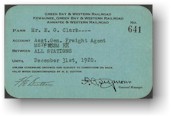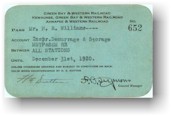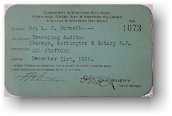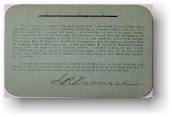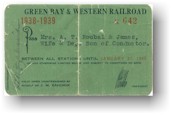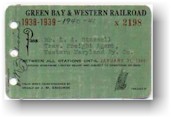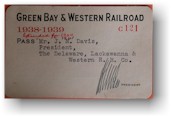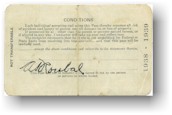|
Home
|
Railroad passes like those below were issued by railroads to allow free travel to employees, their families, and special guests of the line. People traveling with these passes were usually referred to as "dead heads," because they provided no revenue to the trip.
In the 1870's the Green Bay & Minnesota carried an average of 50,000 passengers. The business doubled by the 1880s and peaked at 310,000 in 1915. By 1947 the number of passengers fell to less than 1,000. Passenger service ended on the Kewaunee division in 1937 and the Interstate Commerce Commission granted permission to discontinue all service and the last passenger trains ran on April 4, 1949.
The railroad was never known as an extremely passenger-friendly railroad -- GB&W employees referred to it as the "Grab Bags & Walk" -- but it did run a mixed passenger and freight train throughout the 1940s.
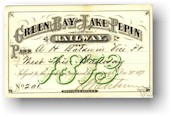 Mr. A. H. Baldwin Vice President North Wisconsin Ry. |
1873 |
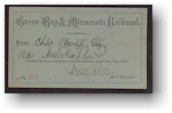 #153: Mr. Charles Fargo American Express Co. |
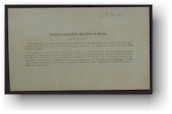 back side |
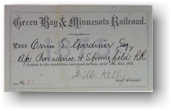 #57: Mr. Orrin Gardiner Providence & Springfield RR |
1875 |
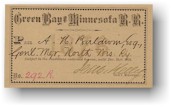 #292R: Mr. A. H. Baldwin General Manager North Wisconsin Ry. |
1876 |
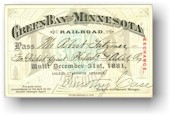 #79: Mr. Robert Gatzmer General Ticket Agent Philadelphia & Atlantic City Railway |
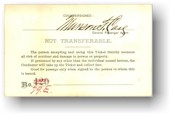 back side |
1881 |
 #79: C.E. Ennover Assistant Freight Agent BH&W Rwy. Co. |
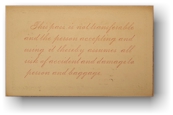 back side |
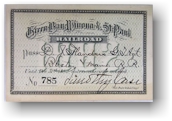 #785: Mr. D. J. Flanders Agent Boston & Maine RR |
1882 |
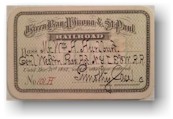 #101 H: Mr. William H. Hurlburt General Western Passenger Agent New York, Lake Erie and Western RR |
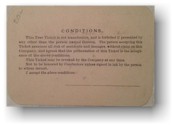 back side |
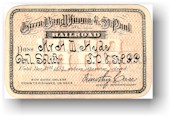 Mr. H. D. Hyde General Solicitor Minneapolis & St. Louis RR |
1883 |
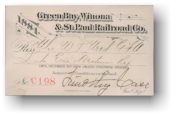 Mr. W.S. Weed General Freight Agent Lake Erie & Western Ry. |
 back side |
1884 |
 #E1178: Mr. E. B. Beardsley Treasurer |
 back side |
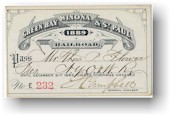 #E232: Thomas P. Fowler President New York, Ontario & Western Ry. |
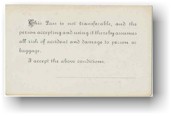 back side |
1889 |
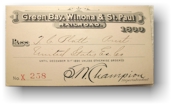 #X258: J.G. Platt |
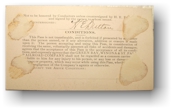 back side |
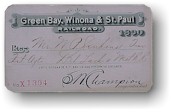 #X1394: Mr. W. Jenkins Traveling Freight Agent Delaware, Lackawanna & Western RR |
 #X1394: Mr. W. Jenkins Traveling Freight Agent Delaware, Lackawanna & Western RR |
1890 |
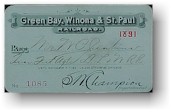 #1085: Mr. W. Jenkins Traveling Freight Agent Delaware, Lackawanna & Western RR |
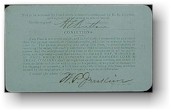 back side |
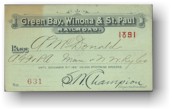 #631: Mr. A. McDonald Assistant General Freight and Passenger Agent Minnesota and Northwestern RR |
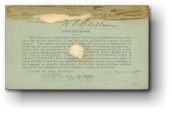 back side |
1891 |
The second pass was issued to an agent of the Minnesota & Northwestern
RR, which became part of the
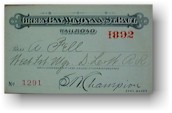 #1291: Mr. A. Fell Western Freight Manager Delaware, Lackawanna & Western RR |
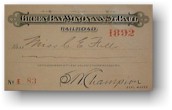 #E83: Miss. C. E. Fell |
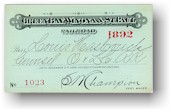 #1023: Louis Heasbrouck |
 back side |
1892 |
The pass is also good for travel on the Kewaunee, Green Bay & Western RR, a newly constructed line, affiliated with the GBW&StP.
Despite the new construction, in reality the GBW&StP was in dire
straights by this time; fine print on the back of the pass indicates that the
railroad was actually in receivership by the Farmers' Loan & Trust Company,
holder of the railroad's mortgage.
1893 |
The second pass shown was issued to the General Superintendent of the
Atlantic & Pacific Railroad. Despite the grandiose name, the A&P
actually went from Albuquerque, New Mexico to Needles, California and became a
part of the Atchison, Topeka, and Santa Fe in 1897.
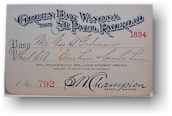 #792: Mr. Geo. A. Gilman General Agent Blue Lines |
1894 |
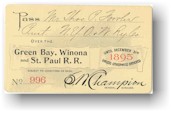 #996: Mr. Thos. P. Fowler President New York Ontario & Western Ry. |
1895 |
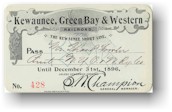 #428: Mr. Thos. P. Fowler President New York Ontario & Western Ry. |
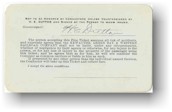 back side |
 #483: Mr. J.D. Hawks Vice-President and General Manager Detroit and Mackinac Ry. |
1896 |
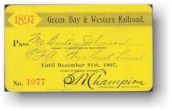 #1077: Mr. Burton Johnson General Freight Agent Wisconsin Central Lines |
1897 |
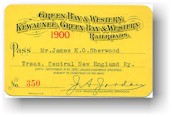 #350: Mr. J. K. O. Sherwood Treasurer Central New England Ry. |
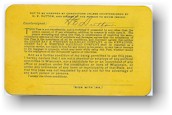 back side |
1900 |
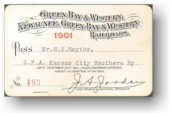 #493: Mr. E. E. Smythe General Freight Agent Kansas City Southern Ry. |
 back side |
1901 |
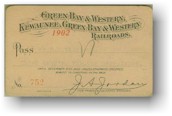 #752: front side |
1902 |
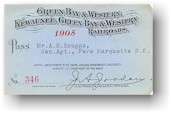 #346: Mr. A. E. Snuggs General Agent Pere Marquette RR |
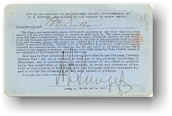 back side |
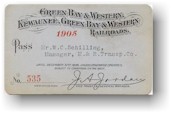 #535: Mr. W. C. Schilling Manager M & R. Transportation Co. |
 #192: Mr. Thos. P. Fowler President New York, Ontario & Western Ry. |
1905 |
 #406: Mr. H. R. Williams Chief Inspector W.C.S. Association |
 #43: Mr. W. C. Schilling Manager M & R. Transportation Co. |
1906 |
This was the last year of Ahnapee & Western independent operation, prior
to the GB&W taking a majority interest that fall. A&W passes were
the same style as the previous year, but in a different color. This pass
was issued to W. C. Schilling of the M & R Transportation Co., the same
person who was issued a 1905 pass from the GB&W.
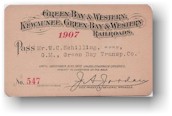 #547: Mr. W. C. Shilling General Manager Green Bay Transportation Co. |
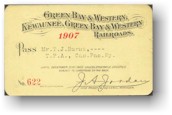 #622: Mr. T. J. Burns T.P.A. Canadian Pacific Ry. |
1907 |
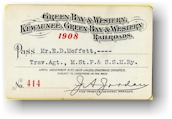 #414: Mr. E. D. Moffett Travel Agent Minneapolis, St. Paul, & Sault Saint Marie Ry |
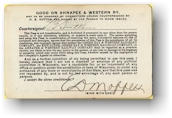 back |
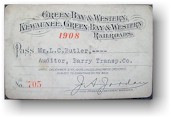 #705: Mr. L. C. Butler Auditor Barry Transportation Cot |
1908 |
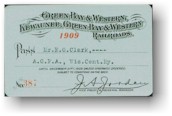 #387: Mr. E. G. Clark A.G.F.A. Wisconsin Central Ry |
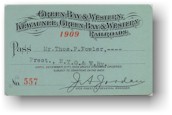 #557: Mr. Thomas P. Fowler President New York, Ontario and Western Ry |
1909 |
1910 |
 #955: Mrs. F. E. Greene Wife of Chief Clerk to General Manager Chicago & North Western Ry |
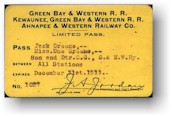 #1027: Mr. Jack Green & Ms. Une Green Son & daughter |
 #107: Mr. E. G. Clark A.G.F.A. Soo Line |
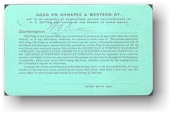 back |
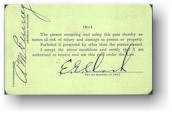 back |
1911 |
There was also a "limited pass" in use as shown in the pass issued to the children of a Chicago & North Western Ry employee.
A Waupaca - Green Bay Ry pass
is also shown. Mr. E. G. Clark is once again shown; this time he
is listed as a Soo Line employee, since the Soo Line acquired the Wisconsin
Central
1912 |
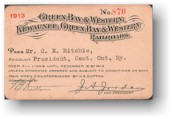 #870: Mr. C. E. Ritchie President Central Ontario Ry. |
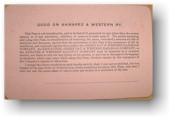 back |
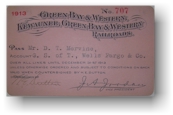 #707: Mr. D. T. Mervine General Superintendent of Traffic Wells Fargo & Co. |
 back |
1913 |
1914 |
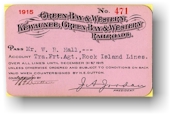 #471: Mr. W. R. Hall Traffic Freight Agent Rock Island Lines |
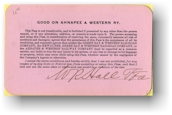 back |
1915 |
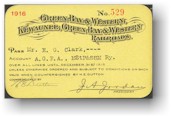 #529: Mr. E. G. Clark A.G.F.A. Minneapolis, St. Paul & Sault Ste. Marie Ry |
1916 |
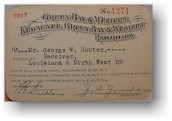 #1271: Mr. George W. Hunter Reciever Louisiana and North West RR |
1917 |
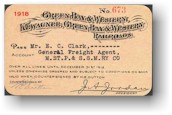 #673: Mr. E.G. Clark General Freight Agent Minneapolis, St. Paul & Sault Ste. Marie Ry |
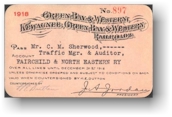 #897: Mr. C. M. Sherwood Traffic Manager & Auditor Fairchild & North Eastern Railway |
1918 |
One of these passes is for Mr. C. M. Sherwood of the Fairchild and
Northeastern, a logging railroad running between Fairchild and Greenwood,
Wis. He would later become the General Manager of the Ettrick Railroad,
a ten-mile short line whose only connection to the outside world was an
interchange with the GB&W at Blair.
1920 |
 #720: Mr. C. Lapham Assistant District Engineer Chicago , Milwaukee & St. Paul Ry |
1921 |
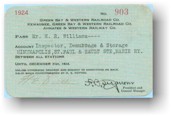 #903: Mr. H.R. Williams Inspector, Demurrage & Storage Chicago, St. Paul, Minneapolis & Omaha RR |
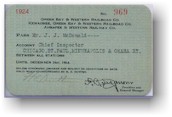 #969: Mr. J.J. McDonald Chief Inspector Chicago, St. Paul, Minneapolis & Omaha RR |
1924 |
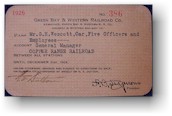 #386: G.H. Wescott, et. al General Manager Copper Range Railroad |
 #1078: H.C. Youngs Lumber Buyer Chicago , Milwaukee & St. Paul Ry |
1926 |
 #1050: Mr. W.J. Sheridan General Western Freight Agent Buffalo, Rochester & Pittsburgh Ry. |
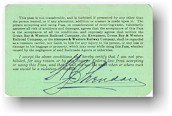 back |
1928 |
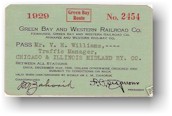 #2454: Mr. V.H. Williams Traffic Manager Chicago & Illinois Midland Ry. |
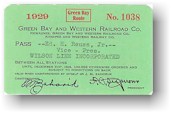 #1038: Mr. Ed H. Reuss, Jr. Vice-president Wilson Lines, Inc. |
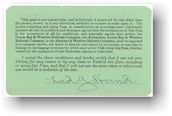 back |
1929 |
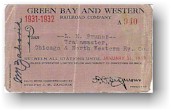 #A940: Mr. L.E. Pruner Trainmaster Chicago & North Western Ry |
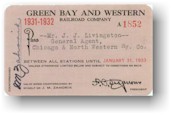 #A1852: Mr. J.J. Livingston General Agent Chicago & North Western Ry |
1931-1932 |
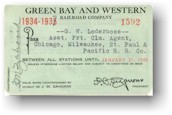 #1592: G. W. Loderhose Assistant Freight Claim Agent Chicago , Milwaukee, St. Paul & Pacific RR |
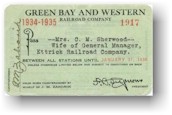 #1917: Mrs. C. M. Sherwood Wife of General Manager Ettrick Railroad Co. |
1934-1935 |
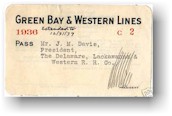 #c2: Mr. J. M. Davis President Delaware, Lackawanna & Western RR |
1936 |
1938-1939 |
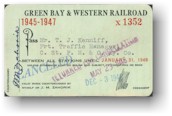 #X1352: Mr. T. J. Kenniff Freight Traffic Manager CMStP&O Ry. Co. |
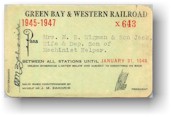 #X643: Mrs. M. B. Wigman & son Jack Wife and dependent son of Machinist Helper Green Bay & Western RR |
1945-1947 |
I hope you enjoyed this trip through the history of passes on the Green Bay & Western lines. If you have any passes I hope you can add to this collection by sharing an image of it.
